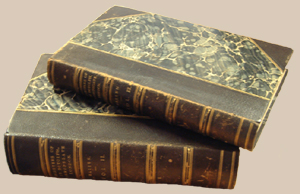Parish Records - An Introduction
 What are Parish Records? What are Parish Records?
Parish Records are records of baptisms, marriages, and burials made by the Church. They are a valuable resource for researching your family tree because the census and official records of birth, marriage and death do not go back further than 1837. Parish records can extend your research back to the time of King Henry VIII. Most parish registers go back to the 1600s, and some even go back to the 1500s.
Phillimore Parish Records is a series of books published in the late 19th and early 20th centuries, and hold transcriptions of marriage registers. Learn more about W.P. Phillimore on the information page.
A baptism record would usually give the name of the child, their parents, and where their parents lived. You can use this information to trace their parents, as their marriage record is likely to be in the same place where they live. The marriage record would give you the parishes of both bride and groom, allowing you to trace their parents in the parish, and so on.
A Short History of Parish Records
As we have seen, both Civil Registration and Census Returns run out when you get back to c.1840, and rarely provide information relevant before 1800. At this stage you need to turn to Parish Records - these date back to 1538 when Cromwell, at the Court of Henry VIII, ordered that every wedding, baptism and burial should be recorded.
Early records were made on paper but from 1558 parchment was used, and the older records were supposed to have been copied, although some never were and have been lost. From 1597 a second copy had to be made and sent to the Bishop - these transcripts are often in better condition and written more legibly.
It is worthwhile investing in Parish maps for your relevant counties - these not only mark the boundaries of each parish and show adjacent parishes (very useful for tracking mobile ancestors!) but can also give dates that registration began in each parish formed before civil registration. One such atlas can be found at GenealogySupplies.com, called the Phillimore Atlas and Index of Parish Registers, is a popular book which gives over 1800 maps and details of how to locate both original parish records and copies of them.
By an act of 1812 baptisms, marriages and burials were entered in seperate, specially printed books, eight entries per page and including more information.
Baptisms included Father's occupation and Mother's maiden name. Marriages included parish of origin of both paries, names, status (e.g. bachelor, widow, etc), ages, signatures/marks, and those of two witnesses. Burials included age, occupation and abode. Between 1678 and 1814 an affidavit was required to be sworn that the deceased was buried in wool or a fine of £5 was given.
Marriages are either by banns or by licence. Banns are found in the parish register, the couple's intention to marry being read on three occasions in the parish churches of both the bride and groom. If you know where the groom lived just before the marriage, this record will tell you of the parish of the intended bride, which is normally where the wedding took place a few weeks later. Licences were sometimes handed to the couple marrying, and have not always survived, though a search can be made for its bond or allegation, which will give information of value, names of those who stood surety, as well as the names of bride and groom and place of marriage, and sometimes occupations of the sureties and groom.
The Phillimore transcripts of parish records go back as far as 1538 for some. W.P. Phillimore was a genealogist who started the job of publishing transcripts of early parish records in the 1890's. These normally end in 1812 or 1837. For the range of years covered you will need to look at the details for the county you're researching. Most of the Phillimore transcripts are of marriages and the complete collection is available from S&N Genealogy
What can a Record tell me - what Information does it hold?
Baptism Records: You should find the name and date of baptism. It is likely that the father's name will be on there.
 Marriage Records: These contain the name of the bride and groom, the Parish where they were married and the date of the ceremony. More information was added in later records. Marriage Records: These contain the name of the bride and groom, the Parish where they were married and the date of the ceremony. More information was added in later records.
Burial Records: You should be able to find the name, the father's name and the date of burial. The age is also noted in later records.
|